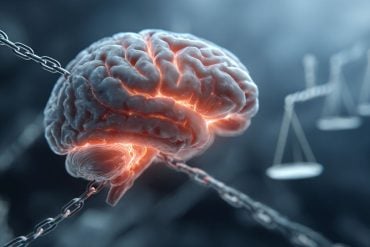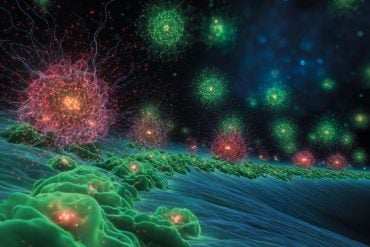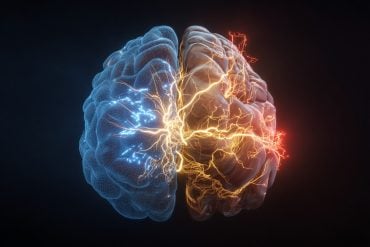Summary: A new study reports blocking specific ADAM enzymes can stop the growth and spread of glioblastoma brain cancer.
Source: University of Southampton.
Researchers from the University of Southampton have discovered a potential way of stopping one of the most aggressive types of brain tumour from spreading, which could lead the way to better patient survival.
Glioblastoma is one of the most common types of malignant brain tumours in adults. They are fast growing and can spread easily. The tumour has threadlike tendrils that extend into other parts of the brain making it difficult to remove it all.
Although there have been great advances made in the treatment of Leukaemia’s and other cancers, little is known about how Glioblastomas are formed and how these tumours infiltrate the brain tissue.
Published in Molecular Neurobiology, the study led by Dr Elodie Siney under the supervision of Dr Sandrine Willaime-Morawek, Lecturer in Stem Cells and Brain Repair at the University, analysed how enzymes called ADAMs affect the movement and function of the human tumour cells.
The findings suggest that if you are able to block specific enzymes called ADAM10 and ADAM17 the tumour stops growing and spreading. It also moves the cancer cells away from the place where they were growing which could allow them to be removed through traditional cancer treatments such as radiotherapy, chemotherapy or surgery.

“When confirmed in animal models of glioblastoma, this finding will be of great importance for patients and clinicians,” said Sandrine. “Glioblastoma is a devastating disease which is often untreatable. We have found that blocking ADAMs may lead to reduced tumour growth and less recurrence following conventional treatments, improving the chance of complete surgical removal and improving survival rates.”
Source: University of Southampton
Image Source: This NeuroscienceNews.com image is in the public domain.
Original Research: Full open access research for “Metalloproteinases ADAM10 and ADAM17 Mediate Migration and Differentiation in Glioblastoma Sphere-Forming Cells” by Elodie J. Siney, Alexander Holden, Elizabeth Casselden, Harry Bulstrode, Gareth J. Thomas, and Sandrine Willaime-Morawek in Molecular Neurobiology. Published online August 19 2016 doi:10.1007/s12035-016-0053-6
[cbtabs][cbtab title=”MLA”]University of Southampton. “New Hope in Fight Against Glioblastoma Brain Cancer.” NeuroscienceNews. NeuroscienceNews, 23 September 2016.
<https://neurosciencenews.com/brain-cancer-glioblastoma-neurology-5112/>.[/cbtab][cbtab title=”APA”]University of Southampton. (2016, September 23). New Hope in Fight Against Glioblastoma Brain Cancer. NeuroscienceNews. Retrieved September 23, 2016 from https://neurosciencenews.com/brain-cancer-glioblastoma-neurology-5112/[/cbtab][cbtab title=”Chicago”]University of Southampton. “New Hope in Fight Against Glioblastoma Brain Cancer.” https://neurosciencenews.com/brain-cancer-glioblastoma-neurology-5112/ (accessed September 23, 2016).[/cbtab][/cbtabs]
Abstract
Metalloproteinases ADAM10 and ADAM17 Mediate Migration and Differentiation in Glioblastoma Sphere-Forming Cells
Glioblastoma is the most common form of primary malignant brain tumour. These tumours are highly proliferative and infiltrative resulting in a median patient survival of only 14 months from diagnosis. The current treatment regimens are ineffective against the small population of cancer stem cells residing in the tumourigenic niche; however, a new therapeutic approach could involve the removal of these cells from the microenvironment that maintains the cancer stem cell phenotype. We have isolated multipotent sphere-forming cells from human high grade glioma (glioma sphere-forming cells (GSCs)) to investigate the adhesive and migratory properties of these cells in vitro. We have focused on the role of two closely related metalloproteinases ADAM10 and ADAM17 due to their high expression in glioblastoma and GSCs and their ability to activate cytokines and growth factors. Here, we report that ADAM10 and ADAM17 inhibition selectively increases GSC, but not neural stem cell, migration and that the migrated GSCs exhibit a differentiated phenotype. We also observed a correlation between nestin, a stem/progenitor marker, and fibronectin, an extracellular matrix protein, expression in high grade glioma tissues. GSCs adherence on fibronectin is mediated by α5β1 integrin, where fibronectin further promotes GSC migration and is an effective candidate for in vivo cancer stem cell migration out of the tumourigenic niche. Our results suggest that therapies against ADAM10 and ADAM17 may promote cancer stem cell migration away from the tumourigenic niche resulting in a differentiated phenotype that is more susceptible to treatment.
“Metalloproteinases ADAM10 and ADAM17 Mediate Migration and Differentiation in Glioblastoma Sphere-Forming Cells” by Elodie J. Siney, Alexander Holden, Elizabeth Casselden, Harry Bulstrode, Gareth J. Thomas, and Sandrine Willaime-Morawek in Molecular Neurobiology. Published online August 19 2016 doi:10.1007/s12035-016-0053-6






